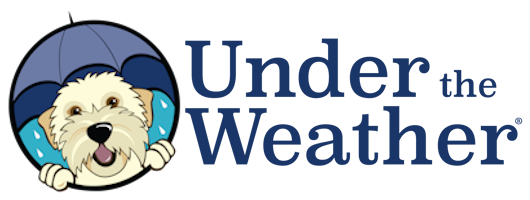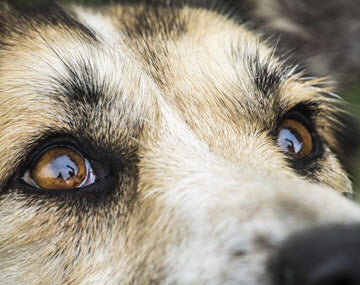Other than a wagging tail, your dog’s eyes communicate so much – that she’s ready for a walk, she’s feeling happy or she wants to play. Her eyes are one of the most precious and complex organs, and maintaining healthy eye function will play a key role to her life-long happiness.
Understanding How Their Eyes Work
The eyes of dogs differ from human eyes in a variety of ways:
- Larger pupils to see better in dimly lit conditions
- Stronger at detecting movement rather than color and detail
- Long-nosed dogs focus sharply at a distance, giving them great peripheral vision
- Short-nosed dogs excel at short-distance vision such as reading your facial expression
- A third eyelid that works as a thin shutter to protect the eyeball
These differences account for them seeing the world in a different way than we do. Most dogs see forms rather than defined images, similar to the way we see at sunset. Dogs rely in their sensitive noses to “see” the world around them; their vision is less important.
Assessing Your Dog’s Eyes
Your dog’s eyes can tell you many things about her health. The ASPCA offers nine health tips to help you recognize healthy eyes as well as help you recognize signs that your dog may need to see a veterinarian or eye specialist.
- In a brightly lit area, look into your dog’s eyes. They should be clear and bright and the white area around the eye should be white. The pupils should be the same size; and healthy eyes would be free of tearing, discharge or crust in the corners. If you see cloudiness, yellowish whites, unequal pupil size or a visible third eyelid, bring your dog to the veterinarian.
- Using your thumb, gently roll down your dog’s lower eyelid so you can see the lining. It should be pink, not red or white.
- If you notice runny eyes or discharge, your dog may have some dirt in her eyes. Gently clean using a damp cotton ball, wiping outward from the corner of the eye. Be careful not to touch her eyeball or scratch the cornea. If the problem continues, your dog may have an eye infection needing the care of your veterinarian.
- Groom the area around your dog’s eyes to keep from hairs poking or scratching their eyes. Use a round-tipped scissors and use extreme care. You might enlist the help of someone to hold your dog’s head during this process.
- Protect your dog’s eyes if you are applying any spray products or flea-control formulas. Avoid grooming products that could be irritating if they get in your dog’s eyes.
- Observe your dog’s behavior. Watch for frequent rubbing of her eyes or squinting. These may be clues that something else is going on and needs veterinarian attention.
- Don’t give in to your dog’s crazy desire to hang her head out the window when you’re driving. The wind can dry your dog’s eyes; and the risk of infection or injury if debris or a bug hits her eye is not worth it.
- Research your dog’s breed to see if she may need more attention throughout her life to maintain optimal eye health.
- Make sure your vet checks your dog’s eyes at your regular well pet checkups.
Changes Brought on By Age
As your dog grows old, she will experience natural changes brought about by the aging process. After the age of 6, many dogs develop clouding of the lenses. This process comes on gradually, and your dog will adapt to these changes.
Night vision will be less acute as they age. Your dog may be more hesitant to go out at night, and extra lighting can help ease her uncertainty.
Some dogs may become more light sensitive as they age, but will adapt as this change slowly develops.
Best Foods for Eye Health
A healthy diet rich with antioxidants is very important in supporting your dog’s eye function. Unless noted, these foods should be fed raw. For the fruits and vegetables, gently puree them for optimal digestion:
- Blueberries – Carotenoids, phytonutrients and flavonoids
- Carrots – Vitamin A and beta-carotene
- Kale – Antioxidants lutein and zeaxanthin
- Broccoli – Beta-carotene
- Sweet Potatoes – Beta-carotene and anthocyanins (always serve well cooked)
- Eggs – Lutein, sulfur and cysteine (lightly cooked or raw)
- Sardines and Salmon – Omega-3 fatty acids, especially DHA (raw salmon must be deep-frozen before serving)
Adding these antioxidants to your dog’s commercial diet will go a long way to supporting their eye health. They will help cushion the effects of the free radicals brought on oxidation. Just like human bodies, free radicals brought on by stress, metabolic functions and poor diet can attack cells and tissues.
Eye tissues are especially sensitive to this free radical damage, but they can also affect your dog’s immune system. Starting at an early age, a diet rich in antioxidants will go a long way to supporting their overall health as they age.
This blog is brought to you by Under the Weather®, provider of bland diet products for dogs. These bland diet products offer a quick and convenient solution when dogs experience digestive issues such as vomiting or diarrhea. Ready to go in minutes – just add boiling water to rehydrate.
Our bland diet recipes are made with 100% human-grade meats – no meat by-products, antibiotic free and no hormones added! They are gluten free and have no chemicals or dyes. Sourced and manufactured in the U.S.A.
View Our Products
Visit Our Blog Library





